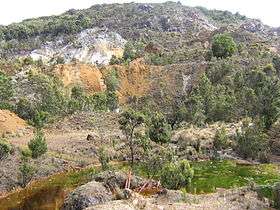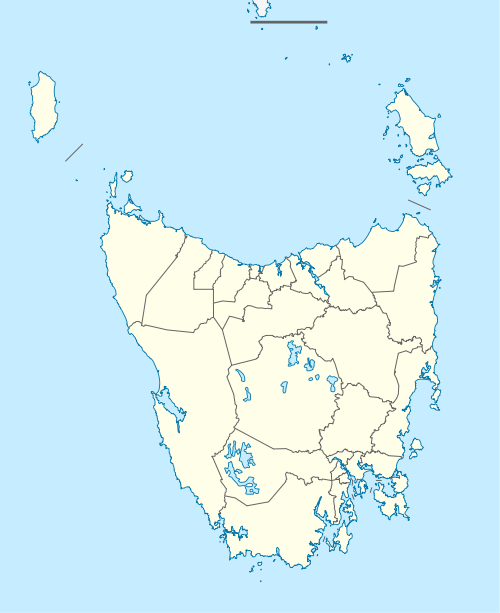Mount Bischoff
Mount Bischoff is a mountain and former tin mine in the north-western region of Tasmania, Australia. The mountain is situated adjacent to Savage River National Park near the town of Waratah.
 Former open cut mine at Mount Bischoff (2006) | |
| Location | |
|---|---|
 Mount Bischoff Location in Tasmania | |
| Location | North West region |
| State | Tasmania |
| Country | Australia |
| Coordinates | 41°25′12″S 145°31′12″E |
| Production | |
| Products | Tin |
| History | |
| Active |
|
| Owner | |
| Company |
|
| Website | metalsx |
Location and features
Tin was discovered at Mount Bischoff in 1871 by James "Philosopher" Smith.[1] The mountain was named in the early nineteenth century after the Chairman of the Van Diemen's Land Company James Bischoff.
The Tin mine
The mine operated successfully at first by the Mount Bischoff Tin Mining Company,[2] using sluicing with water from the top of the waterfall in Waratah.[3][4] In June 1883, the mine installed one of the first hydro-electric generators in Australia and employed it to light the offices, workshop and manager's house.[5][6] The easy ore was all extracted by 1893 when sluicing was discontinued. Mining continued opencut on the face of the mountain, and underground. The manager of the mine from 1907 to 1919 was John Dunlop Millen; he was "credited with the modernisation of the mine’s facilities and was regarded by all those associated with the mine’s operations as an effective manager".[7] The underground mine closed in 1914, but surface mining continued for some time before it also ceased after the price of tin slumped in 1929. The mine was reopened by the Commonwealth Government in 1942 to support the war effort, but it finally closed in 1947.[8] The mine was connected to the Emu Bay Railway by the Waratah Branch of that railway which was run from Guildford Junction to Waratah between 1900 and mid 1940.
The 2000s revival
After several minor attempts, in 2008 Metals X Limited, a Perth-based mining company, through its subsidiary Bluestone Mines Tasmania Pty Ltd, the operator of the Renison Bell, one of largest tin mines in the world today, decided to mine the remaining tin at Mount Bischoff to blend with ore at its Renison Bell operation. A large open cut operation taking in all the old historic workings was developed at Mount Bischoff for this purpose with the ore being trucked 80 kilometres (50 mi) to the Renison Bell processing plant. At the time ore reserves at Mount Bischoff were estimated to be 845,000 tonnes (832,000 long tons) grading at 1.20 percent tin. In 2009/10 198,000 tonnes (195,000 long tons) of ore was mined at the Mount Bischoff open pit that produced 6,267 tonnes (6,168 long tons) of tin in concentrate. The open cut mine at Mount Bischoff is currently on care and maintenance. Bluestone Mines Tasmania Pty Ltd is continuing its exploration program at Mount Bischoff.[9]
References
- Bacon, Carol (2006). Mount Bischoff. The Companion to Tasmanian History. Centre for Tasmanian Historical Studies, University of Tasmania. Retrieved 1 July 2015.
- https://trove.nla.gov.au/people/1477269?q=mount+bischoff&c=people Entry about the Tin Mining Company
- "MOUNT BISCHOFF". The Tasmanian. Tasmania, Australia. 22 February 1879. p. 7. Retrieved 2 January 2020 – via Trove. item about sluicing being suspended when lack of water available
- Ulrich, George H. F. (George Henry Frederick); Mount Bischoff Tin Mining Co (1874), The Mount Bischoff tin mines : Mr. Ulrich's report to the directors of the Mount Bischoff Tin Mining Company, Launceston, s.n, retrieved 2 January 2020
- Burgess, Julian (2016). Duck Reach and Launceston's Electric Light. Christopher (Gus) Green. p. 13. ISBN 978-0-994 1608-1-2.
- "The engineering feats of Tasmania's hydro electric system". ABC Hobart. Australian Broadcasting Corporation. Retrieved 4 January 2020.
- Bennett, Scott (2004). "Millen, John Dunlop (1877–1941)". The Biographical Dictionary of the Australian Senate. 2. Melbourne University Press.
- Interpretive sign at the former mine site
- "Mt Bischoff". Mining Link. Retrieved 1 July 2015.
Further reading
- Blainey, Geoffrey (2000). The Peaks of Lyell (6th ed.). Hobart: St. David's Park Publishing. ISBN 0-7246-2265-9.
- Haygarth, Nic (2004). Baron Bischoff: Philosopher Smith and the birth of Tasmanian mining. ISBN 0-9585831-1-0.
- McIntosh Reid, A. (1923). The Mount Bischoff Tin Field (PDF). Geological Survey Bulletin No. 34. Hobart: Department of Mines, Government of Tasmania.
- Whitham, Charles; Mount Lyell Tourist Association (1924). Western Tasmania : a land of riches and beauty. Mount Lyell Tourist Association. Retrieved 7 June 2018. - see (pages 74–78)